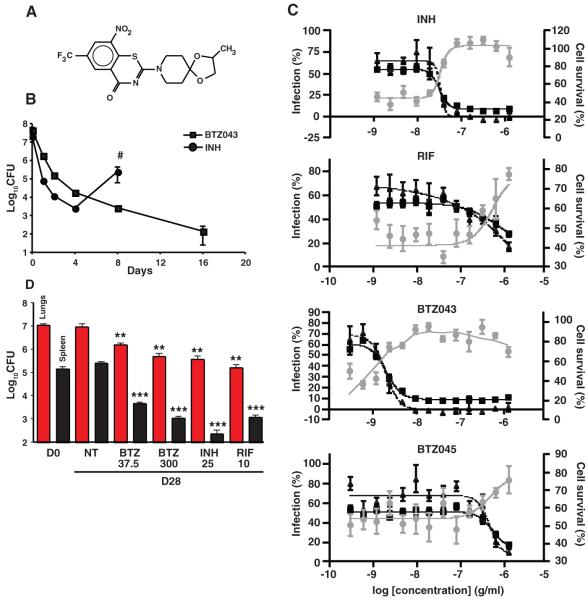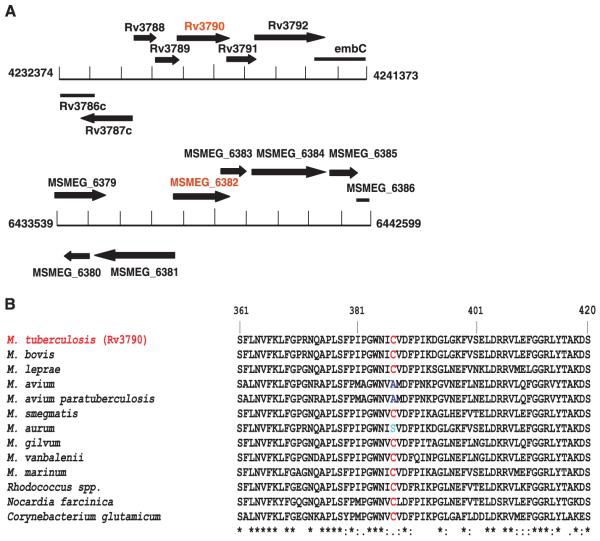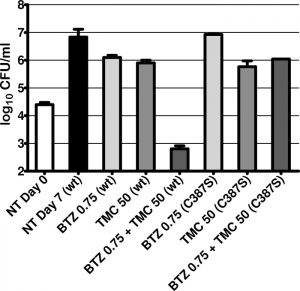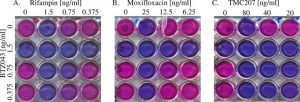This product is for research use only, not for human use. We do not sell to patients.
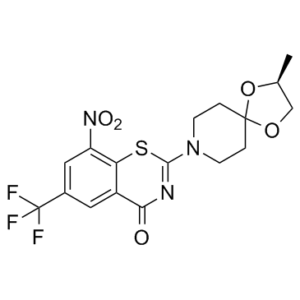
| Size | Price | Stock |
|---|---|---|
| 250mg | $1080 | Check With Us |
| 500mg | $1650 | Check With Us |
| 1g | $2475 | Check With Us |
Cat #: V2971 CAS #: 1161233-85-7 Purity ≥ 98%
Description: BTZ043, also known as 8-Nitro-benzothiazinones (BTZs), is a potent inhibitor of decaprenyl-phosphoribose-epimerase (DprE1) with MIC values of of 2.3 nM and 9.2 nM for M. tuberculosis H37Rv and Mycobacterium smegmatis, respectively. It has potential to be used as a antimycobacterial agent that kill Mycobacterium tuberculosis by blocking arabinan synthesis. The inhibition of BTZ-resistant DprE1 followed the trend observed in the MIC measurements, with the C387G mutant being more resistant to inhibition by PyrBTZ01, PyrBTZ02, and BTZ043 (7- to 9-fold increases in IC50) than the C387S mutant (2.5- to 4-fold increases in IC50). Structure-activity relationship (SAR) studies revealed the 8-nitro group of the BTZ scaffold to be crucial for the mechanism of action, which involves formation of a semimercaptal bond with Cys387 in the active site of DprE1. BTZ043 presented favorable in vitro absorption-distribution-metabolism-excretion/toxicity (ADME/T) and in vivo pharmacokinetic profiles. BTZ043 did not show efficacy in a mouse model of acute tuberculosis, suggesting that BTZ-mediated killing through DprE1 inhibition requires a combination of both covalent bond formation and compound potency.
Publications Citing InvivoChem Products
Product Promise

- Physicochemical and Storage Information
- Protocol
- Related Biological Data
- Stock Solution Preparation
- Quality Control Documentation
| Molecular Weight (MW) | 431.39 |
|---|---|
| Molecular Formula | C17H16F3N3O5S |
| CAS No. | 1161233-85-7 |
| Storage | -20℃ for 3 years in powder formr |
| -80℃ for 2 years in solvent | |
| Solubility In Vitro | DMSO: 13.3 mg/mLr |
| Water: <1 mg/mLr | |
| Ethanol: <1 mg/mL | |
| SMILES Code | O=C1N=C(N(CC2)CCC32OC[C@H](C)O3)SC4=C([N+]([O-])=O)C=C(C(F)(F)F)C=C14 |
| Synonyms | BTZ043; BTZ 043; BTZ-043. |
| Protocol | In Vitro | In vitro activity: BTZ043, also known as 8-Nitro-benzothiazinones (BTZs), is a potent inhibitor of decaprenyl-phosphoribose-epimerase (DprE1) with MIC values of of 2.3 nM and 9.2 nM for M. tuberculosis H37Rv and Mycobacterium smegmatis, respectively. It can display nanomolar bactericidal activity against Mycobacterium tuberculosis in vitro. The inhibition of BTZ-resistant DprE1 followed the trend observed in the MIC measurements, with the C387G mutant being more resistant to inhibition by PyrBTZ01, PyrBTZ02, and BTZ043 (7- to 9-fold increases in IC50) than the C387S mutant (2.5- to 4-fold increases in IC50). Structure-activity relationship (SAR) studies revealed the 8-nitro group of the BTZ scaffold to be crucial for the mechanism of action, which involves formation of a semimercaptal bond with Cys387 in the active site of DprE1. BTZ043 presented favorable in vitro absorption-distribution-metabolism-excretion/toxicity (ADME/T) and in vivo pharmacokinetic profiles. BTZ043 did not show efficacy in a mouse model of acute tuberculosis, suggesting that BTZ-mediated killing through DprE1 inhibition requires a combination of both covalent bond formation and compound potency. Kinase Assay: BTZ043, also known as 8-Nitro-benzothiazinones (BTZs), is a potent inhibitor of decaprenyl-phosphoribose-epimerase (DprE1) with MIC values of of 2.3 nM and 9.2 nM for M. tuberculosis H37Rv and Mycobacterium smegmatis, respectively. Cell Assay: The MIC of BTZ043 against M. tuberculosis H37Rv and Mycobacterium smegmatis are 1 ng/mL (2.3 nM) and 4 ng/mL (9.2 nM), respectively. The in vitro activity of BTZ043 against 30 Nocardia brasiliensis isolates is also tested. The MIC50 and MIC90 values for BTZ043 are 0.125 and 0.25 μg/mL. The MIC for N. carnea ATCC 6847 is 0.003μg/mL, for N. transvalensis ATCC 6865 is 0.003μg/mL, for N. brasiliensis NCTC10300 is 0.03 μg/mL, and for N. brasiliensis HUJEG-1 is 0.125μg/mL. The MIC value for M. tuberculosis H37Rv is 0.000976 μg/mL. The MIC value of BTZ-043 is >64 μg/mL for Escherichia coli ATCC 25922 and S. aureus ATCC 2921. |
|---|---|---|
| In Vivo | BTZ-043 were administered at 100 mg/kg twice daily by gavage, and sulfamethoxazole/trimethoprim (SXT), at 100 mg/kg sulfamethoxazole, was used as a positive control | |
| Animal model | BALB/c mice infected with a low bacillary load (~200 CFU) of M. tuberculosis H37Rv via aerosol. | |
| Formulation | Formulated in carboxymethyl cellulose formulation (0.25%) | |
| Dosages | 7.5, or 300 mg/kg; p.o. once daily |
| Solvent volume to be added | Mass (the weight of a compound) | |||
|---|---|---|---|---|
| Mother liquor concentration | 1mg | 5mg | 10mg | 20mg |
| 1mM | 2.3181 mL | 11.5904 mL | 23.1809 mL | 46.3618 mL |
| 5mM | 0.4636 mL | 2.3181 mL | 4.6362 mL | 9.2724 mL |
| 10mM | 0.2318 mL | 1.1590 mL | 2.3181 mL | 4.6362 mL |
| 20mM | 0.1159 mL | 0.5795 mL | 1.1590 mL | 2.3181 mL |
This equation is commonly abbreviated as: C1 V1 = C2 V2
- (1) Please be sure that the solution is clear before the addition of next solvent. Dissolution methods like vortex, ultrasound or warming and heat may be used to aid dissolving.
- (2) Be sure to add the solvent(s) in order.





































